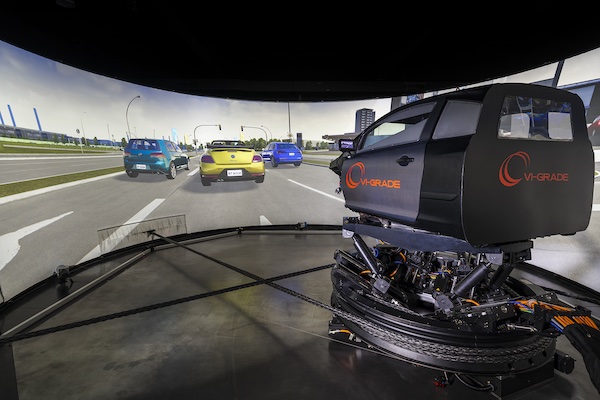Driving Simulators Hit the Road
The combination of Adams multi-body dynamics simulation software and VI-grade driving simulators will help car makers create safer driving experiences.

The Adams Real Time multi-body dynamics simulation software is now validated for VI-grade driving simulators. Image Courtesy of Hexagon Manufacturing Intelligence
Latest News
August 31, 2022
You don’t have to drive a Tesla or high-end BMW to be treated to the latest advanced vehicle features, whether that’s blind-spot alerts or more sophisticated autonomous driving capabilities.
Today, across the spectrum, the latest models feature such capabilities, aided in part by more widespread use of driving simulators and advanced simulation software to minimize reliance on physical prototypes and to throttle up new car delivery cycles. Industry watcher Grandview Research projects the global driving simulator market will grow at a CAGR of 3.4% between 2016 and 2027, fueled by automotive manufacturers growing investment in sensors and processors that could benefit from early testing performed with driving simulators.
In one example that showcases the momentum, Hexagon’s Manufacturing Intelligence division has partnered to validate its Adams Real Time multi-body simulation software for operation on VI-grade driving simulators. With the automotive industry under constant pressure to meet evolving market demands in the face of smaller budgets and accelerated product development timelines, the combination simulation software and simulator environment offers a path to developing safer and more compelling driver experiences far more quickly than creating physical prototypes.
The Adams software and Adams Real Time Hardware-in-the-Loop (HIL) capabilities can be used to create virtual vehicle prototypes that bridge the gap with physical testing. The high-fidelity simulations help engineering teams evaluate their decisions against an array of conditions, including ride, handling, and durability targets in order to produce safer and more comfortable cars.
The VI-grade simulators enable physical testing of such CAE models without the need to manufacture prototypes of systems or vehicles. The VI-grade validation means Adams Real Time has passed stringent tests for real-time reliability and safety. The combination of the two platforms enables engineering organizations to leverage a common vehicle model for both offline development and connected real-time applications, officials said.
“This single-model development paradigm multiplies the productivity, cost reduction, and product performance value … to enable more reliable end-to-end processes and improve collaboration,” said Chris Baker, head of System Dynamics software at Hexagon.
For example, the simulation models routinely created for vehicle dynamics and handling can now be used for real-time testing and validation tasks performed on VI-grade simulators simply by applying Adams Real Time settings. Moreover, using a consistent, high-fidelity Adams vehicle model throughout the product development cycle increases productivity, helps drive down costs, and results in higher performance end products, officials claimed. Finally, a single-model approach also helps eliminate unproductive and error-prone translations between different simulation tools.
Watch this video to learn more about Adams Real Time.
More Hexagon Manufacturing Intelligence Coverage
Subscribe to our FREE magazine, FREE email newsletters or both!
Latest News
About the Author
Beth Stackpole is a contributing editor to Digital Engineering. Send e-mail about this article to DE-Editors@digitaleng.news.
Follow DE




